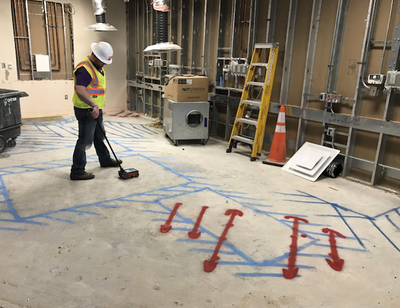
Hospital Floor Scan in Plano, Texas
Hospital jobs tend to be relatively difficult and high-stakes. Hospitals are large buildings, and they are often irregularly shaped, which means they have unusual configurations of reinforcing steel in their slabs. This makes concrete scanning more challenging than in a typical rectangular structure. Additionally, hospitals have critical utilities that can literally make the difference between life and death.
On a recent job in Plano, Texas, we scanned the floor of a hospital structure in order to map out all critical utilities and reinforcing steel, including beams. In most buildings, you can guess where the beams are simply by looking (or shining a laser) up, because beams usually run in a set pattern all the way up a structure. That was not the case on this job. Only one of the main diagonal beams was consistent between our floor and the floor overhead. The rest of the beams ran in alternate pattern, which we marked out with blue paint (see photo). Additionally, there were large pieces of rebar running diagonally across the main beams and into the slab, and there were smaller pieces of steel running in a tight grid throughout the whole scan area. We communicated the latter fact to the customer, and we were told those lines did not need to be marked, as they were consistent.
Our customer was surprised by the layout of the slab, as his team was not aware that the pattern would differ from what they could see overhead. Had they not scanned the slab (assuming it to follow the same pattern as above) they may have encountered major issues before noticing to pattern. But this particular customer has been in the business a long time with an excellent record, and they knew not to take that risk. They now have all the information they need to lay out their penetrations. Before we left the site, they asked us to schedule another visit so that we could scan a separate area.
Avoiding unknown risks is what we do at GPRS, and hospitals are an important example of the critical role that GPR plays in construction projects. Drilling through a slab always presents some level of risk, but this risk is rarely higher than in a hospital, where the stakes are so high. With that elevated risk, the cost effectiveness of a GPR scan only increases. GPR cannot always reduce the risk to zero—sometimes it can, but other times there are situational limitations—but getting a GPR scan is such a cheap (relative to the cost of repairing damaged cables, conduits, beams, etc.) way to vastly reduce the risk of unknown subsurface items, and the secondary risks those damages impose.
Additionally, we provide our customers with the defensible position of showing they took all the proper steps of risk alleviation. In this way, we push back a small piece of the brokenness in the world, and work together to make things run smoothly. In some cases, we may even be pushing a core drill off a piece of conduit that was critical to life. The crazy thought is, we may never know what disaster was averted, continuing on about our projects as if nothing happened. We may move our core 6” off a marker-drawn arrow on the ground labeled “🡸conduit🡺” and then never give it a second thought. But from that moment forward, we will live in an alternate and better reality, where that life-saving conduit was not cut. That better reality is the one we seek and fight for every day at GPRS, and we could not do it without our many customers who choose to do the work the right way rather than the easy way. Thank you, sincerely.
To request a quote or schedule a scan, call Lisa at 214.471.9001.
